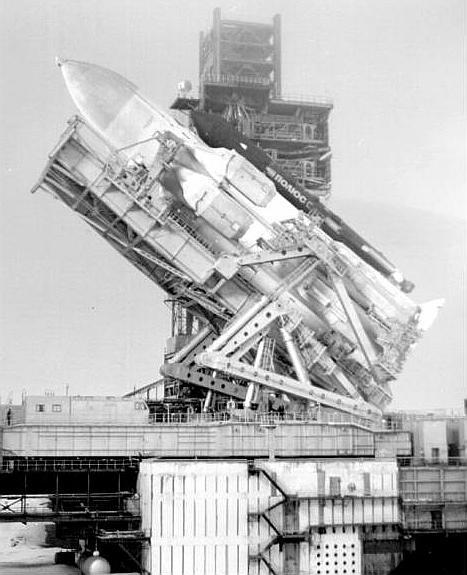In 1987, the Soviet Union launched a manned space laser battle station called Polyus toward low Earth orbit. You can read more about that here:
Polyus
I say "toward" LEO rather than into LEO because Polyus didn't wind up making it that far. The spacecraft weighed about 80 metric tons fueled and ready for launch, and the only rocket capable of delivering such a large spacecraft into orbit was the brand-new Energiya system.
Incidentally, "Energiya" means "Energy" and "Polyus" means "Staff" (the kind you'd use to fight off ninjas) in Russian, so the combined Energiya-Polyus launch stack literally means "Energy Staff." Russians really have the best names for everything.
Energiya was an awkward beast primarily designed to launch Buran, the Soviet knockoff of the American space shuttle orbiter. While she was flexible enough to also launch heavy outsize payloads, there was no payload fairing or attachment system at the top of the launch vehicle. Instead, the payload had to be bolted onto Energiya's side and would have to provide its own protection from the aerothermodynamic loads of ascent.
As it turned out, the easiest way to accommodate Polyus was to mount it upside-down, engines facing forward, on its launch vehicle's side. As Randall Munroe notes, if you want to go to space, the engines need to face backward, so Polyus was programmed to rotate 180 degrees after separating from the launch stack, then fire its engines briefly to enter its final orbit. In a heartbreaking turn of events, Energiya worked just fine on her maiden launch, but a software glitch caused Polyus to yaw through a full circle rather than the planned half circle after separation. The spacecraft slowed, and plunged into the south Pacific near New Zealand about half an hour later.
It's probably for the best that things turned out this way. Polyus was armed with a megawatt-class carbon dioxide laser capable of rendering enemy (which meant American in those days) satellites useless across thousands of miles of empty space. The functional cargo block attached to the aft end housed propulsion, a defensive cannon, and quarters for a maintenance crew, though in a good move for a peaceful world, the nuclear space mines were deleted form the final launch configuration. It seems the Soviets just couldn't give up on the spectacle of a manned military space program, and stuck it with mega-engineering projects in space right to the end of the Cold War.
One last thought: As insane as this whole idea was, the sight of an 80-tonne space laser lurching off the pad in blizzard conditions is a grotesquely beautiful thing:

"Polyus" doesn't mean "Staff", it means "Pole", as in North Pole.
ReplyDelete